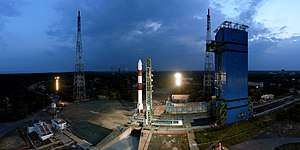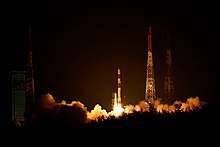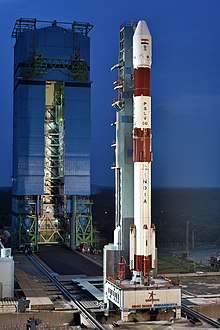PSLV-C42
 | |
| Mission type | Deployment of 2 satellites |
|---|---|
| Operator | ISRO |
| Website | ISRO website |
| Spacecraft properties | |
| Spacecraft | Polar Satellite Launch Vehicle |
| Spacecraft type | Expendable launch vehicle |
| Manufacturer | ISRO |
| Launch mass | 230,400 kilograms (507,900 lb) |
| Payload mass | 889 kilograms (1,960 lb) |
| Dimensions |
44.4 metres (146 ft) (overall height) |
| Start of mission | |
| Launch date | 10:08:00, 16 September 2018 (IST) |
| Rocket | Polar Satellite Launch Vehicle |
| Launch site | Sriharikota Launching Range |
| Contractor | ISRO |
| Payload | |
| Mass | 889 kilograms (1,960 lb) |
PSLV-C42 was the 44th mission of the Indian Polar Satellite Launch Vehicle (PSLV) program and its 12th mission in the Core Alone (CA) configuration. PSLV-C42 successfully carried and deployed 2 earth observation satellites in sun-synchronous orbits at an altitude of 588 kilometres (365 mi). It was launched on 16 September 2018 by the Indian Space Research Organisation (ISRO) from the first launch pad of the Satish Dhawan Space Centre at Sriharikota, Andhra Pradesh. The 2 international satellites were launched as part of a commercial arrangement between Surrey Satellite Technology Limited (SSTL) and ISRO's commercial arm Antrix Corporation Limited, run under the auspices of the Indian Government's Department of Space.
Launch

The PSLV-C42 was launched from the first launch pad of the Satish Dhawan Space Centre in Sriharikota at 10:08 P.M. IST on 16 September 2018, after a 33-hour countdown that began at 1:08 P.M. IST on 15 September 2018.[1][2] The launch was the 44th flight of the PSLV rocket and the 12th in the Core Alone (CA) configuration, which is the lightest version of the PSLV without the six strap-on motors, and is used for launching small payloads.[3][2][4] It was the first fully commercial launch of the PSLV rocket in 2018 after a five-month hiatus since its last launch on 12 April 2018, and only the third launch after a rare launch failure on 31 August 2017.[1][2][4]
The PSLV-C42 carried 2 United Kingdom earth observation satellites into sun-synchronous orbit, namely NovaSAR and S1-4.[1] The first stage of the rocket separated about two minutes after the lift-off, while the fourth stage separated almost fifteen minutes later.[1][3] Both satellites were subsequently placed in sun-synchronous orbits 17.44 minutes after the launch at an altitude of 588 kilometres (365 mi).[1][3] R. Hutton, mission director for the PSLV C-42 launch, said: "This was a spectacular mission. We have placed the satellite in a very, very precise orbit".[5]
The PSLV-C42 launch was a night launch and was carried out for the first time by ISRO upon the request by the Surrey Satellite Technology Limited (SSTL), whose satellites were launched, in order to achieve a specific orbit.[4][6] "The PSLV-C42 marks the latest technology and commercial collaboration between India and the UK with the launch of the combination of high resolution optical and radar (SAR) satellites from us," said Martin Sweeting, group executive chairman of SSTL.[4]
With this launch, the total number of foreign satellites launched by ISRO reached 239 of 28 different countries.[4]
Mission parameters

- Mass:
- Total liftoff weight: 230,400 kilograms (507,900 lb)
- Payload weight: 889 kilograms (1,960 lb)
- Overall height: 44.4 metres (145.7 ft)
- Propellant:
- Stage 1: Composite Solid
- Stage 2: Earth Storable Liquid
- Stage 3: Composite Solid
- Stage 4: Earth Storable Liquid
- Propellant mass:
- Stage 1: 138,200 kilograms (304,700 lb)
- Stage 2: 42,000 kilograms (93,000 lb)
- Stage 3: 7,600 kilograms (16,800 lb)
- Stage 4: 2,500 kilograms (5,500 lb)
- Maximum vacuum thrust:
- Stage 1: 4846.9 kN
- Stage 2: 803.78 kN
- Stage 3: 239.6 kN
- Stage 4: 2 x 7.33 kN
- Altitude: 588 kilometres (365 mi)
- Maximum velocity: 7,566.69 metres per second (24,825 ft/s) (recorded at time of NovaSAR and S1-4 separation)
- Inclination: 97.806°
- Azimuth: 140°[3]
The PSLV C-42 rocket had four stages; each one was self-contained, with its own propulsion system, thereby capable of functioning independently.[3][4] The first and third stages used composite solid propellants, while the third and fourth stage used earth-storable liquid propellants.[3] It had a lift-off mass of 230,400 kilograms (507,900 lb) and measured 44.4 metres (146 ft) in height. It carried two earth observation satellites built by SSTL into orbit, weighing 445 kilograms (981 lb) and 444 kilograms (979 lb) respectively, bringing the total payload mass to 889 kilograms (1,960 lb).
The two satellites were placed in a sun-synchronous orbit at 588 kilometres (365 mi) altitude and 97.806° inclination.
References
- 1 2 3 4 5 Kumar, Chethan (16 September 2018). "Isro's PSLV successfully puts two UK earth observation satellites into orbit". The Times of India. Retrieved 19 September 2018.
- 1 2 3 D.S., Madhumathi (15 September 2018). "PSLV to launch two U.K. satellites today". The Hindu. Retrieved 19 September 2018.
- 1 2 3 4 5 6 "PSLV-C42 Brochure". ISRO.
- 1 2 3 4 5 6 "PSLV-C42 launches 2 foreign satellites" (Press release). ISRO. 16 September 2018. Retrieved 19 September 2018.
- ↑ Rohit, T.K. (16 September 2018). "ISRO's PSLV-C-42 launches two U.K. satellites". The Hindu. Retrieved 12 October 2018.
- ↑ Singh, Surendra (17 September 2018). "Isro to launch 18 missions in next six months". The Times of India. Retrieved 19 September 2018.
External links
| Wikimedia Commons has media related to PSLV-C42. |